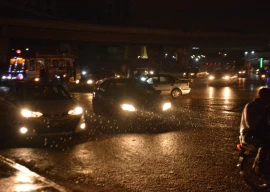
I need to start with a word of explanation why I have given so much space to the discussion of the Summit of Americas held in Los Angeles from June 8 to June 10, thousands of miles from Pakistan. I do so in the belief that some of what was discussed by the attending leaders have relevance for Pakistan. A major subject for the Summit was international migration which is bringing hundreds of thousands of people out of their own countries where their lives were not secure and trying to gain admission to the places where they could earn a decent living. They were mostly moving to the United States and other places in Latin America. A large number headed to the United States, and some also went to the relatively more developed countries in the region. This situation was not very different from the one Pakistan is facing with reference to Afghanistan. The difference was that the Latin countries were prepared to take collective action. Pakistan was more or less on its own.
The ninth Summit of the Americas held in Los Angeles was a three-day affair from June 8 to 11. One of the topics on the mind of the American president was the sharp increase in the number of people who wanted to enter the United States from the southern border. Was the Summit well-timed? asked several Latin American leaders. “I don’t hold an enormous amount of hope for any major breakthrough,” said Andres Rozental who was the deputy foreign minister of Mexico for six years. “People will be skeptical and then they will have to wait and see if anything comes of it.”
He and other political commentators felt that the American president had other things on his mind to fully focus on his country’s relations with the nations on the south. There was the war in Ukraine and his commitment to contain the rise of China so that it did not become a real competitor for the United States. However, the US officials working on the Summit said that the United States would propose American reforms to the Inter-American Development Bank to encourage more investment in the region in addition to investments of $300 million by the United States to combat food security.
A day before the leaders began their talks, US Vice President Kamala Harris announced pledges of $1.9 billion in outlays by private companies over the next several years. But the Latin Americans felt that these efforts would not shut China out of the region. “He can hardly cover infrastructure needs here,” said Rozental. “Biden’s program called Build Back Better has fallen pretty much by the wayside. There just isn’t anything in the cards that would indicate to me that Biden is going to come up with some sort of a big New Deal for Latin America.”
Mass migration from Central America through Mexico remained a big problem for the Biden administration. His administration gave up on the heavy-handed approach his predecessor Donald Trump had adopted, hoping to reduce the need to move by developing more rapidly the three Central American countries known as the northern Triangle — Guatemala, Honduras and El Salvador — which along with Mexico are the source of 66 per cent of the illegal migration at the US border. However, some Latin countries did not send their presidents to the meeting as a protest against Washington’s decision not to invite some of the Latin leaders it saw as authoritarian.
There were serious doubts among experts that flow of money to the region would reduce pressure on the border. Billions of dollars had flowed into the region over the years, some of it overseen by Biden when he was vice president and appointed by Barack Obama to develop the Alliance for Prosperity. In 2015, that programme sent $750 million to the Northern Triangle countries with the goal of providing economic stability to dissuade people from migrating north. “The potential arrival of a caravan of migrants during Mr. Biden’s summit could add an opportunity for his critics to attack his handling of the border,” wrote Michael D Shear in his coverage of the Summit for his newspaper, The New York Times. The Republicans critical of Biden’s handling of migrants inspired fear by falsely describing migrants as gangs and criminals. “In fact, most of the groups are families — including children — fleeing violence and economic migrants eager for jobs in the United States. Many caravans break apart before reaching the border.”
The three-day summit ended on Friday, June 10, 2022, with an agreement called the Los Angeles Declaration on Migration and Protection. It committed the United States to taking in 20,000 refugees from Latin America during the next two years, a three-fold increase. President Biden also pledged to increase the number of seasonal worker visas from Central America and Haiti. This meant only a small fraction of the migrants who try to cross the United States’ southwestern border. The countries that signed the agreement pledged to accept a small fraction of the number of people leaving their homes in search of life elsewhere. About six million displaced Venezuelans have fled the economic and political turmoil in their country in the last five years to Colombia, Peru and Ecuador among other countries. Central Americans facing gang violence and climate change have sought fresh starts in Mexico as well as the United States.
Would the attention given to the large-scale movement of people in the Latin American sub-continent set a precedence of dealing with the movements of millions of people in Central and South Asia? As recent reports by several UN agencies have pointed out, displacement of people in this part of the world has set new records. Those displaced in Afghanistan and because of the continuing turmoil in the Middle East, millions of people are seeking refuge in neighbouring countries. Pakistan, Iran and Turkey have accommodated several million people without much help from the outside. The decisions taken at the Summit of the Americas could be replicated to take care of these people but it seems unlikely that anything like that would happen in our part of the world. While desperate people from Central America are leaving their homes and attempting to enter the United States, these are not “climate refugees” who are likely to be displaced in South Asia. The recent floods in Bangladesh and Northeast India have left tens of thousands pf people homeless. They are also looking for safer places, for the time being looking for high ground. But there is not much high ground in Bangladesh or in the state of Assam in India’s northeast. Ultimately, they too would walk long distances to find safety. The late June earthquake in southeast of Afghanistan right on the border with Pakistan has also displaced thousands pf people. They are bound to head for Pakistan.
The countries in this part of the world should take a leaf out of the book of the Americas. Pakistan could perhaps take the lead and convene a conference to be attended by a dozen or so countries that have had to deal with mass movements of people. The international development banks working in the region and national aid giving agencies as the USAID should be invited to develop a plan resembling the one worked out in the Los Angeles Summit.
Published in The Express Tribune, June 27th, 2022.
Like Opinion & Editorial on Facebook, follow @ETOpEd on Twitter to receive all updates on all our daily pieces.




1736064364-0/aubrey-(1)1736064364-0-165x106.webp)
1729161093-0/liam-(4)1729161093-0-165x106.webp)














COMMENTS
Comments are moderated and generally will be posted if they are on-topic and not abusive.
For more information, please see our Comments FAQ